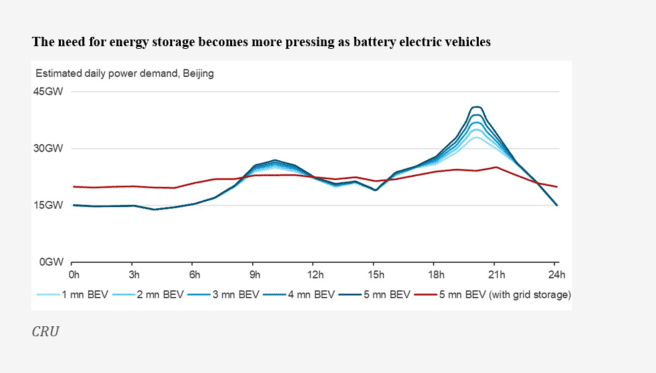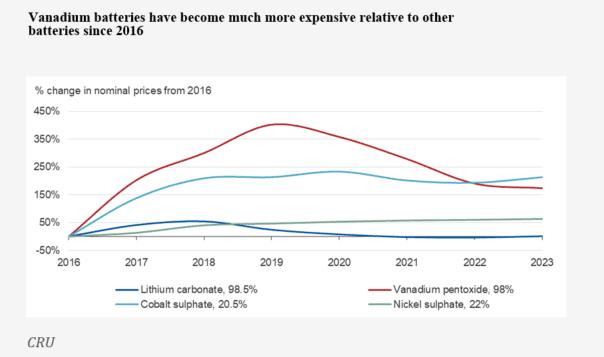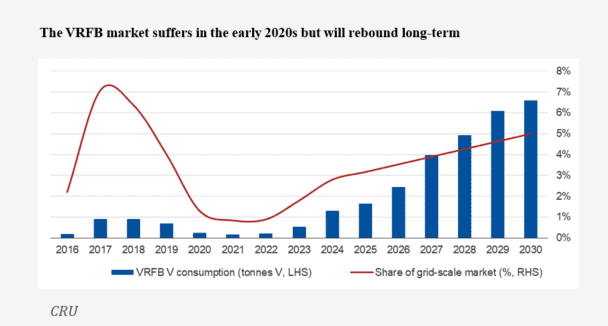Vanadium has been heralded as the future of energy storage technology. Vanadium redox flow batteries (VRFBs) possess a range of properties that make them favourable for peak control, supplementary power, and frequency regulation. The energy storage sector itself is also expecting massive growth over the next decade. Despite this, the project pipeline for vanadium-based energy storage is looking bleak.
The reason: high vanadium prices have stalled investment. Vanadium prices have been driven up almost 580% since Q4 2015 as a result of increasing tightness in the spot market. Supply has been stretched so thin that stockpiles have fallen below ten weeks’ worth of consumption. The resulting price rise has been proportionally much larger than the recent gains in cobalt, around which there has been a lot of excitement and investor speculation. However, unlike cobalt, vanadium has not cemented its place in the battery space yet. How long will these supply problems last and will a cooldown be permanently detrimental to the VRFB market?
Tightness in supply
Adding small amounts of vanadium to steel can drastically increase its strength. On 1st November 2018, a new standard for hot-rolled rebar went into effect in China. This standard, GB/T 1499.2-2018, eliminates low-strength 335MPa rebar and establishes three new higher-strength grades: 400MPa, 500MPa and 600MPa. An important effect of this is the prohibition of water-cooling as a method of strengthening hot-rolled rebar, effectively necessitating the addition of vanadium instead.
Prior to the announcement of this standard, many Chinese steel producers passed off the inferior water-cooled rebar as the micro-alloyed, vanadium-bearing kind. Unfortunately, while water-cooling does improve the yield strength and elongation on the surface, it also reduces the earthquake and fatigue-resistance of the bar. A substantial amount of China, including the area around Beijing, is vulnerable to serious earthquakes. The inferior re- bar posed considerable safety risks wherever it was used in construction. Thus, demand was higher for the micro-alloyed bar. However, production costs are greater and standards were lax, so mislabelling the product led to a quick profit. Spotting this, the Chinese government stepped in.
Since the announcement in February that the government would be intensifying its watch for non-compliant rebar, steel producers have ramped up their consumption of vanadium. We at CRU expect most non-compliant rebar will rapidly leave the market now that the new standard has come into force. CISRI conducted a sampling exercise among Chinese steel mills and found that almost 40% would be non- compliant under the new standard. For the average underperforming producer of 400-series rebar to meet the standard, they will need to increase vanadium consumption by 0.23kg/t rebar. Even more will be needed to meet the higher grades.
We expect 209.8 million tonnes of Chinese rebar will be produced within the next year. With the inclusion of the 500- and 600-series bars, this will lead China to consume 40% more vanadium over the course of the year – totalling over 70,000 tonnes. Whilst this might be offset by niobium consumption, due to its lower price and comparable strengthening effects, so far, the impact has been squarely on vanadium supply.
With suppliers already nearing nameplate production, there simply isn’t the flexibility to respond to increasing demand. We don’t expect this will be alleviated until planned brownfield expansions and mine restarts come into operation, which may be as far out as 2022.

Energy storage
What does this mean for the fledgling vanadium battery market? The main use for VRFBs is in grid-scale energy storage. As the consumption of energy is growing around the world, its management is also becoming more difficult. The spread of renewable energy sources increases the variability of power generation and the need for some kind of smoothing mechanism. The expected take-off in the number of battery electric vehicles (BEVs) on the roads will introduce massive uncertainty into demand too. Grid-scale energy storage solutions become increasingly important as these sectors grow, and VRFBs have garnered a lot of attention as one such solution. The need for energy storage becomes more pressing as battery electric vehicles multiply.
In 2010, VRFBs consumed no vanadium at all; in 2017, demand from batteries was 1,830 tonnes (in the form of vanadium pentoxide, V O ). As the stationary energy storage market itself is expected to expand twenty times over between 2018 and 2030 – from 13GWh to 268GWh – the potential for this source of demand to grow is huge.
Currently, pumped hydroelectricity facilities dominate the energy storage industry at 96% of global in- stalled capacity. However, such facilities are expensive and difficult to construct. This leaves an opening for the expansion of alternative technologies. Other technologies currently used include thermal storage (1.9%), electrochemical (1.1%), and mechanical (0.9%).
VRFBs have such high potential in this area for a number of reasons. Their energy capacity can be scaled up very easily and virtually infinitely. More importantly, cost-effectiveness increases with scale, unlike with lithium-ion batteries (LIBs). VRFBs can also be cycled thousands of times with negligible degradation, and even refuelled instead of recharged, depending on configuration. Their main drawback is their low energy density, which prevents their use in mobile applications such as BEVs.

These advantages have not been missed. According to the US Department of Energy, as of June 2018 there were 856MWh of vanadium batteries announced, contracted or under construction throughout the world. How- ever, the Rongke Power development in Dalian, China makes up 800MWh of this. Beyond it’s completion, no further major VRFB projects are planned, and we do not expect there to be until prices fall.

Prices are such an important factor for VRFBs because vanadium can be between 30% and 50% of the total installed cost. Every GWh of new capacity requires 5,500 tonnes of vanadium. Whereas technology development can reduce the proportion of more expensive component metals in LIBs, no such breakthroughs are even on the horizon for VRFBs. This means that VRFBs will continue to be extremely sensitive to movements in the vanadium price. So it is worrying for the development of the sector that vanadium pentoxide has risen in price more than any other major battery chemical since 2016.
Does this mean VRFBs will lose out in favour of other options? While high prices persist, the answer has to be ‘yes’. We expect VRFB share of the stationary energy storage market to continue to decline, falling below 2% in 2020.
As the technology with much higher energy density and much more research and development activity, LIBs seem like the obvious competitor to steal the lead. However, there are still limitations to the use of LIBs in energy storage. Just as in a smartphone, grid-scale storage can degrade significantly over time, which is totally at odds with decades-long life expectancy of infrastructure installations. Worse still, LIBs can generate large amounts of heat. To operate effectively at scale, installations will need to be effectively refrigerated, adding to both capital and operating costs.
Where we expect LIBs to do much better is in the residential energy storage sector. With distributed energy generation becoming more popular, such as solar panels on the roofs of homes, energy storage offers a way to save for when the sun isn’t shining. This division of the market is why our out- look for VRFBs remains positive in the longer-term; vanadium retains its edge at commercial scale. From 2022, we predict that VRFBs will begin to reclaim market share, and by 2030 should be in a relatively market share position to now, albeit in a dramatically larger market.










